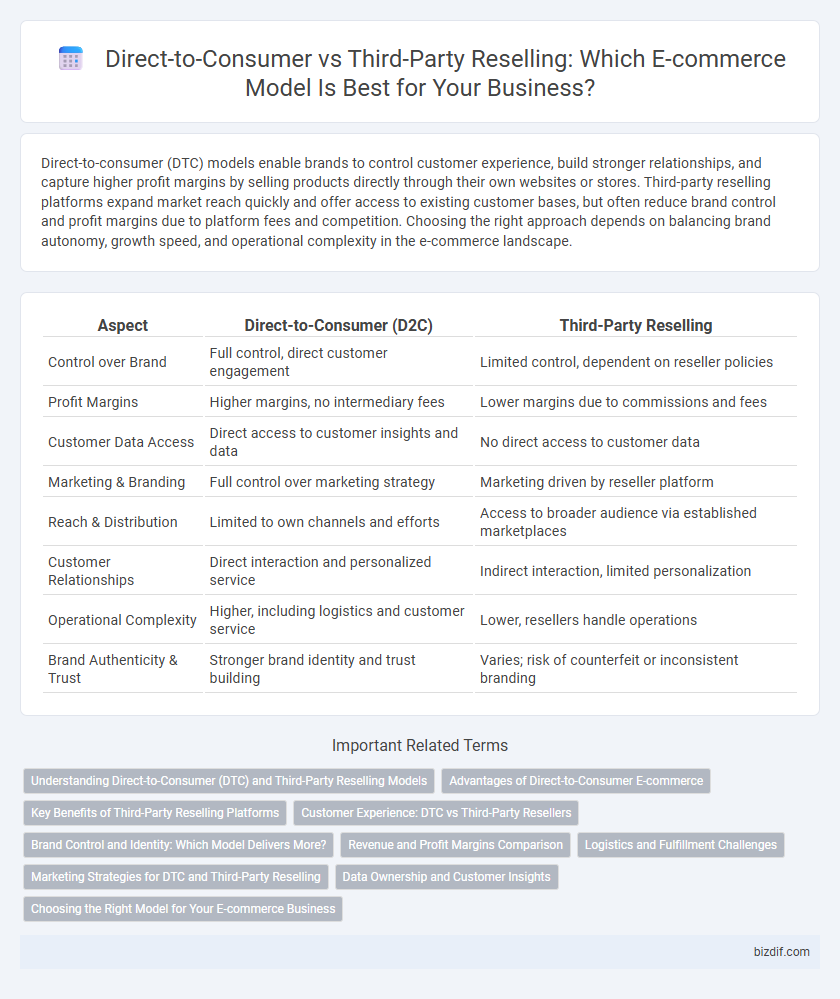Direct-to-consumer (DTC) models enable brands to control customer experience, build stronger relationships, and capture higher profit margins by selling products directly through their own websites or stores. Third-party reselling platforms expand market reach quickly and offer access to existing customer bases, but often reduce brand control and profit margins due to platform fees and competition. Choosing the right approach depends on balancing brand autonomy, growth speed, and operational complexity in the e-commerce landscape.
Table of Comparison
| Aspect | Direct-to-Consumer (D2C) | Third-Party Reselling |
|---|---|---|
| Control over Brand | Full control, direct customer engagement | Limited control, dependent on reseller policies |
| Profit Margins | Higher margins, no intermediary fees | Lower margins due to commissions and fees |
| Customer Data Access | Direct access to customer insights and data | No direct access to customer data |
| Marketing & Branding | Full control over marketing strategy | Marketing driven by reseller platform |
| Reach & Distribution | Limited to own channels and efforts | Access to broader audience via established marketplaces |
| Customer Relationships | Direct interaction and personalized service | Indirect interaction, limited personalization |
| Operational Complexity | Higher, including logistics and customer service | Lower, resellers handle operations |
| Brand Authenticity & Trust | Stronger brand identity and trust building | Varies; risk of counterfeit or inconsistent branding |
Understanding Direct-to-Consumer (DTC) and Third-Party Reselling Models
Direct-to-Consumer (DTC) e-commerce allows brands to sell products directly to customers, eliminating intermediaries and providing greater control over pricing, branding, and customer data. Third-party reselling involves platforms like Amazon or eBay, where sellers leverage existing marketplaces to reach a broader audience but often face higher fees and less control over customer relationships. Understanding these models helps businesses decide whether to prioritize direct engagement with consumers or utilize established marketplaces for expanded reach.
Advantages of Direct-to-Consumer E-commerce
Direct-to-consumer (DTC) e-commerce offers brands complete control over customer experience, enabling personalized marketing and direct feedback collection that enhances product development. This model eliminates intermediaries, increasing profit margins by reducing costs associated with third-party resellers and distributors. Brands leveraging DTC can build stronger customer loyalty through tailored communications and exclusive offerings unavailable on external marketplaces.
Key Benefits of Third-Party Reselling Platforms
Third-party reselling platforms offer e-commerce businesses expanded market reach by leveraging established customer bases, increasing product visibility and sales potential. These platforms handle logistics, payment processing, and customer service, allowing brands to focus resources on product development and marketing. Access to advanced analytics and promotional tools on third-party sites helps optimize inventory management and target advertising more effectively.
Customer Experience: DTC vs Third-Party Resellers
Direct-to-consumer (DTC) brands maintain full control over customer experience, offering personalized service, seamless returns, and consistent branding, which enhances customer loyalty and satisfaction. Third-party resellers often face limitations in customizing interactions and may provide inconsistent service levels due to varied seller policies, impacting trust and repeat purchases. Data-driven insights from DTC sales channels enable targeted marketing and product development, whereas third-party platforms restrict access to firsthand customer data.
Brand Control and Identity: Which Model Delivers More?
Direct-to-Consumer (D2C) e-commerce provides brands with unparalleled control over their identity by managing the entire customer experience, from marketing to fulfillment, ensuring consistent messaging and brand presentation. Third-party reselling platforms, while offering broader market access, often dilute brand identity due to standardized listings and limited customization options, reducing the ability to differentiate. Data shows that 78% of consumers prefer purchasing directly from brands to engage with authentic brand narratives, emphasizing D2C's advantage in maintaining brand integrity.
Revenue and Profit Margins Comparison
Direct-to-consumer (DTC) models often yield higher revenue per sale due to elimination of intermediary fees, directly boosting profit margins. Third-party reselling typically results in lower margins as platforms charge commissions ranging from 10% to 30%, significantly reducing overall profitability. DTC strategies also offer enhanced control over pricing and customer data, which can optimize lifetime value and long-term revenue growth.
Logistics and Fulfillment Challenges
Direct-to-Consumer (DTC) models require robust in-house logistics and fulfillment systems to ensure timely deliveries, manage inventory accurately, and handle returns efficiently, directly impacting customer satisfaction and brand loyalty. Third-party reselling leverages established third-party logistics providers (3PLs) or marketplaces, which can reduce operational complexities but limit control over shipping speed, packaging standards, and customer experience. Optimizing fulfillment strategies in e-commerce necessitates balancing control with scalability, as DTC offers customization potential while third-party reselling demands reliance on external fulfillment infrastructures.
Marketing Strategies for DTC and Third-Party Reselling
Direct-to-Consumer (DTC) marketing strategies emphasize brand storytelling, personalized customer experiences, and leveraging social media platforms for direct engagement, enabling businesses to build strong customer loyalty and gather first-party data. In contrast, Third-Party Reselling relies heavily on marketplace optimization, paid advertising within platform ecosystems, and dynamic pricing strategies to increase visibility and compete against numerous sellers. Both approaches require targeted content marketing and customer segmentation but differ in control over branding and customer interaction channels.
Data Ownership and Customer Insights
Direct-to-Consumer (DTC) channels grant brands full data ownership, enabling direct access to detailed customer insights such as purchasing behaviors, preferences, and demographics. Third-party reselling platforms limit data visibility, restricting brands to aggregate sales information without granular customer data. Owning comprehensive data in DTC models empowers personalized marketing strategies and enhances customer lifetime value optimization.
Choosing the Right Model for Your E-commerce Business
Direct-to-Consumer (DTC) e-commerce enables brands to maintain full control over product presentation, customer experience, and profit margins by selling directly through their own platforms. Third-party reselling offers broad market access and established customer bases via platforms like Amazon and eBay, but often incurs fees and limits brand control. Evaluate factors such as target audience, marketing budget, and scalability potential to determine whether a DTC approach or leveraging third-party marketplaces aligns better with your e-commerce business goals.
Direct-to-Consumer vs Third-Party Reselling Infographic

 bizdif.com
bizdif.com